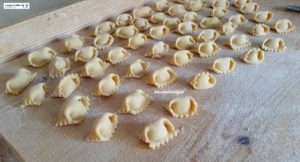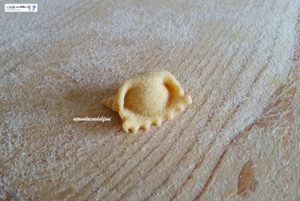Ingredienti per 2 persone
per la pasta:
- 80 g di semola rimacinata di grano duro pugliese
- 30 g di farina di grano tenero di tipo1 macinata a pietra
- 1 uovo medio di masseria bio
per il ripieno:
- 150 g di cipollotti pugliesi (sponsali, solo la parte bianca)
- 1 cucchiaio di olio extra vergine di olive ogliarola del tarantino
- 50 ml di brodo vegetale
- 1 cucchiaio di pane grattugiato casereccio
- 70 g di patata rossa calabrese
- sale e pepe
per la fonduta di pecorino:
- 50 g di formaggio pecorino pugliese stag. 6 mesi
- 30 ml di latte intero
per condimento:
- 120 g di piselli freschi di Fasano (Br) sgusciati
- 20 g di fave di Talsano (Ta) sgusciate e spellate
- 30 g di asparagi di Altedo Igp già puliti
- 1 cipollina bianca
- acqua qb
- 15 g di burro di panna centrifugato
- sale e pepe
- barbe di finocchio
Procedimento per il ripieno: pelare, cubettare e lessare la patata, sgocciolare su un canovaccio ed asciugarla, inserirla in una ciotola, schiacciarla con una forchetta e ridurla in crema.
In una casseruola far rosolare con l’olio i cipollotti tritati finemente, aggiungere il sale, il brodo e il pepe, cuocere a fuoco molto basso fino a che il liquido sia del tutto evaporato e i cipollotti risultino cotti e cremosi. Far raffreddare.
Porre i cipollotti, la patata e il pane grattugiato in una ciotola, amalgamare, dovrà risultare un composto omogeneo, introdurre in un sac a poche e mettere in frigorifero.
Procedimento per la pasta: disporre a fontana su un piano in legno la semola rimacinata e la farina, inserire al centro l’uovo e se necessario 1 cucchiaio di acqua fredda. Amalgamare l’impasto con cura, formare una palla, avvolgerla in pellicola e far riposare per 1/2 ora, tirare poi una sfoglia rettangolare.
Sistemare sulla sfoglia piccole quantità di ripieno, posizionandole a circa un centimetro sia dal bordo della pasta, sia l’una dall’altra. Ripiegare delicatamente il bordo della sfoglia e chiudere pizzicando (pizzicotto=plin in dialetto piemontese) all’altezza di ogni ripieno. Separare ogni plin uno ad uno con l’apposita ruota dentata e far riposare per 1 ora.
Procedimento per la fonduta al pecorino: portare quasi ad ebollizione il latte, togliere dal fuoco, aggiungere il formaggio e mescolare con un frustino. Inserire in un biberon e tenere in caldo.
Procedimento per il condimento: in una casseruola far rosolare la cipollina tritata con l’olio, aggiungere 100 g di piselli, un mestolino di acqua, il sale e cuocere per 10 minuti con coperchio. Frullare e tenere in caldo.
Tagliare a rondelle i gambi degli asparagi evitando le punte.
In una casseruola capiente far rosolare con il burro, i restanti piselli, le fave e gli asparagi per 4 minuti a fiamma bassa, salare e pepare.
Lessare i plin in abbondante acqua salata per 1 minuto, sgocciolarli ed inserirli nella padella degli ortaggi, amalgamare con cura.
Impiattare la crema di piselli, i plin ai piselli, fave e asparagi, rifinendo il piatto con la fonduta di pecorino e barbe di finocchio.
Buon appetito
759
“Plin” with spring onion fondant with peas, broad beans, asparagus and pecorino cheese
Ingredients for 2 people
for pasta:
- 80 g of re-milled durum wheat semolina from Puglia
- 30 g of stone-ground type 1 soft wheat flour
- 1 medium organic farm egg
for the stuffing:
- 150 g of Apulian spring onions (sponsali, only the white part)
- 1 tablespoon of extra virgin olive oil from Tarantino Ogliarola
- 50 ml of vegetable broth
- 1 tablespoon of homemade breadcrumbs
- 70 g of Calabrian red potato
- salt and pepper
for the pecorino fondue:
- 50 g of Apulian pecorino cheese matured 6 months
- 30 ml of whole milkfor seasoning:
- 120 g of shelled fresh peas from Fasano (Br)
- 20 g shelled and peeled Talsano (Ta) fava beans
- 30 g of already cleaned Altedo Igp asparagus
- 1 white onion
- water to taste
- 15 g of centrifuged cream butter
- salt and pepper
- fennel beards
In a saucepan brown the finely chopped spring onions with oil, add the salt, broth and pepper, cook over very low heat until the liquid has completely evaporated and the spring onions are cooked and creamy. Leave to cool.
Place the spring onions, the potato and the breadcrumbs in a bowl, mix together, it must be a homogeneous mixture, put in a bag with a spout and put in the refrigerator.
Place small quantities of filling on the pastry, placing them about a centimeter both from the edge of the pasta and from each other. Gently fold the edge of the sheet and close by pinching (pizzicotto = plin in Piedmontese dialect) at the height of each filling. Separate each “plin” one by one with the appropriate gear wheel and let it rest for 1 hour.
Procedure for the pecorino fondue: bring the milk almost to the boil, remove from the heat, add the cheese and mix with a whisk. Insert in a bottle and keep warm.
Procedure for seasoning: in a saucepan brown the chopped spring onion with oil, add 100 g of peas, a ladle of water, salt and cook for 10 minutes with a lid. Blend and keep warm.
Cut the asparagus stalks into slices, avoiding the tips.
In a large saucepan, brown the remaining peas, beans and asparagus with the butter for 4 minutes over low heat, season with salt and pepper.
Boil the “plins” in abundant salted water for 1 minute, drain them and put them in the pan of the vegetables, mix well.
Serve the pea cream, the “plin” with peas, fava beans and asparagus, finishing the dish with the pecorino fondue and fennel beards.
Enjoy your meal



